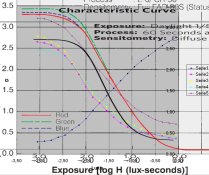Another thing is printing that image on VC paper optically. I guess you realize that you would need a complex masking in the enlarging or an special development of film, or both.
Go and look at Michael Kenna's night work. It's almost all regular 400 speed films (predominantly regular Tri-X) processed in D-76 at a standard time (12 mins I recall - a CI of about 0.7 or what used to be recommended as 'N' for diffusion/ cold cathode). Your approach is giving you difficulty because you are likely underexposing and by the sounds of it underprocessing too. It should take about 1 roll of film and a contact sheet to learn the necessary - 12 mins in Xtol 1+1 & a set of exposures of a stop greater than the last (say 3, 6, 12 mins etc) would seem like a good starting point - the contact print should tell you whether you are within half a grade of where you need to go - there should be an eminently printable neg somewhere in the set. Some papers can be tricky in terms of dumping shadow values at a higher grade - MGIV for example - Classic etc is much better. Main thing to remember is that night images are hard to truly overexpose - and that the approach of the least possible exposure and least possible processing are really facets of trying to minimise grain on 35mm, not necessarily get the best possible tonality in a relatively small enlargement off 8x10. What really matters is making the best possible print, then understanding what your processes were to get there, rather than attempting to analyse that-which-does-not-exist-yet in the hopes of making a 'correct' negative.





